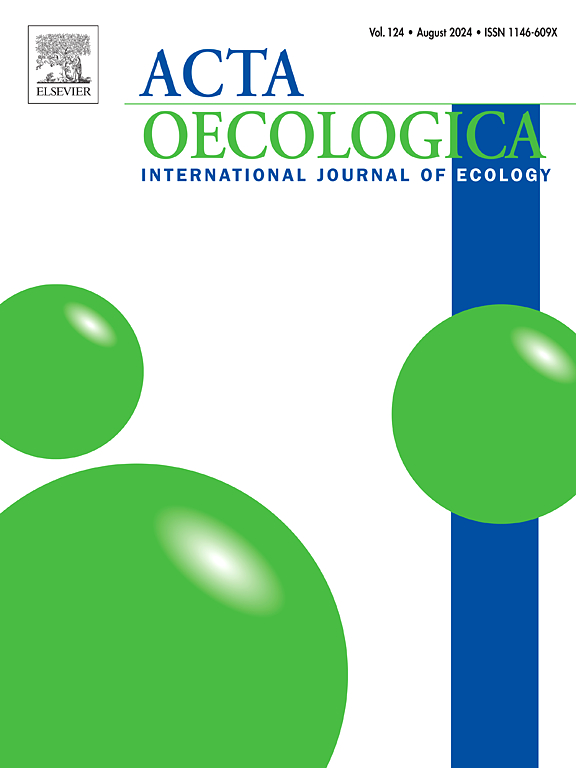Unraveling niche complementarity and mass ratio hypotheses along Amazon forest succession: Functional composition a key factor for restoration
IF 1.3
4区 环境科学与生态学
Q3 ECOLOGY
Acta Oecologica-International Journal of Ecology
Pub Date : 2025-04-23
DOI:10.1016/j.actao.2025.104083
引用次数: 0
Abstract
Understanding the relationship between biodiversity and aboveground biomass in tropical forests is a matter of global interest to mitigate climate change. Therefore, the niche complementarity (NCH) and mass ratio (MRH) hypotheses have been suggested to explain the simultaneous influence of functional trait diversity and composition on ecosystem functioning. The NCH emphasizes resource complementarity among multiple functional traits, while the MRH highlights the dominant role of traits from the most abundant species in driving ecosystem functions. We hypothesize that aboveground biomass increases with stand age, soil nutrients, and soil textural properties and that variation in aboveground biomass could be explained individually or jointly by NCH and MRH along Amazon forest succession. We evaluated different structural equation models to determine the direct and indirect effects of stand age, soil texture, fertility, and residual effects of functional diversity and community-weighted mean (CWM) trait values (tree diameter, wood density) on aboveground biomass. We collected data using 45 sample plots (20 m × 50 m) established in four old-growth and second-growth forests along a successional gradient from three sites in the northern region of Amazonas State, Venezuela. The MRH model showed that stand age had a strong direct positive effect on aboveground biomass, followed by a positive effect of CWM DBH and soil texture but a negative effect of soil fertility on aboveground biomass. The NCH model showed that stand age had the strongest direct positive effect on aboveground biomass, followed by the positive effects of soil texture and functional divergence and the negative direct effects of soil fertility. The integrative SEM for MRH and NCH showed that stand age had a positive direct effect on aboveground biomass, followed by the positive effect of soil texture and CWM DBH, but a negative direct effect on soil fertility. This emphasizes the need for management practices that promote the growth of larger trees within restored areas. Our research provides practical insights that can be applied in passive a active restoration.
亚马逊森林演替过程中生态位互补和质量比假说的揭示:功能组成是恢复的关键因素
了解热带森林生物多样性与地上生物量之间的关系,对于减缓气候变化具有全球利益。因此,提出了生态位互补(NCH)和质量比(MRH)假说来解释功能性状多样性和组成对生态系统功能的同时影响。NCH强调多种功能性状之间的资源互补,MRH强调物种最丰富的性状对生态系统功能的主导作用。我们假设地上生物量随林龄、土壤养分和土壤质地特性的增加而增加,并且地上生物量的变化可以单独或共同由NCH和MRH在亚马逊森林演替中解释。我们评估了不同的结构方程模型,以确定林龄、土壤质地、肥力、功能多样性和群落加权平均(CWM)性状值(树径、木材密度)的剩余效应对地上生物量的直接和间接影响。我们在委内瑞拉亚马逊州北部地区的3个地点沿演替梯度在4个原生林和次生林中建立了45个样地(20 m × 50 m),收集了数据。MRH模型表明,林龄对地上生物量有较强的直接正影响,其次是CWM、DBH和土壤质地对地上生物量的正影响,土壤肥力对地上生物量的负影响。NCH模型表明,林龄对地上生物量的直接正向影响最大,其次是土壤质地和功能分化的正向影响,土壤肥力的直接负向影响。MRH和NCH的综合SEM表明,林龄对地上生物量的直接影响为正,其次是土壤质地和CWM胸径,而对土壤肥力的直接影响为负。这强调需要采取管理措施,促进恢复区域内大树的生长。我们的研究提供了实际的见解,可以应用于被动和主动修复。
本文章由计算机程序翻译,如有差异,请以英文原文为准。
求助全文
约1分钟内获得全文
求助全文
来源期刊
CiteScore
3.60
自引率
0.00%
发文量
57
审稿时长
>0 weeks
期刊介绍:
Acta Oecologica is venue for the publication of original research articles in ecology. We encourage studies in all areas of ecology, including ecosystem ecology, community ecology, population ecology, conservation ecology and evolutionary ecology. There is no bias with respect to taxon, biome or geographic area. Both theoretical and empirical papers are welcome, but combinations are particularly sought. Priority is given to papers based on explicitly stated hypotheses. Acta Oecologica also accepts review papers.

 求助内容:
求助内容: 应助结果提醒方式:
应助结果提醒方式:


